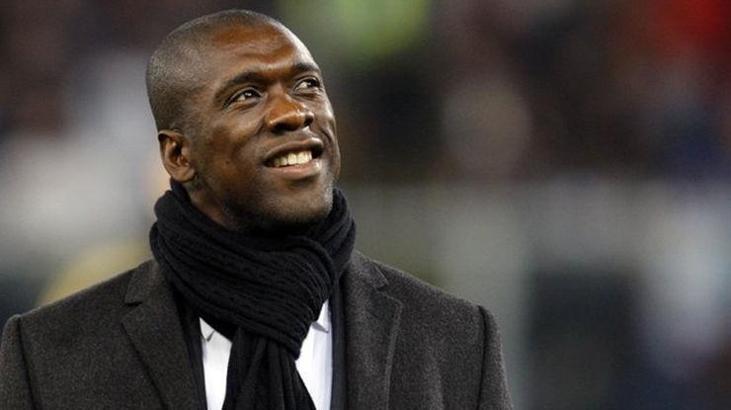Clarence Seedorf (Part 2)
Clarence Seedorf (Part 2)

Seedorf played a pivotal role as AC Milan claimed the Serie A title in the 2003-2004 campaign. This triumph marked his fourth national league title, adding to his previous successes in the Netherlands with Ajax and in Spain with Real Madrid.
Seedorf continued to excel for AC Milan in the Champions League, contributing significantly to their journey to the final in 2005. Despite his efforts, Milan suffered a heartbreaking defeat in the final against Liverpool, famously surrendering a 3-0 lead to eventually lose on penalties in a match that became known as the "Miracle of Istanbul." Despite this disappointment, Seedorf's contributions to AC Milan's success during his tenure at the club were widely recognized.
Clarence Seedorf's illustrious career at AC Milan was marked by numerous successes and remarkable achievements. During the 2005-06 season, Seedorf played a pivotal role in the club's journey to the Champions League final, where they faced off against Liverpool once again. This time, Milan emerged victorious with a 2-1 win in Athens, securing Seedorf's fourth Champions League medal. Additionally, Seedorf was instrumental in Milan's triumph in the 2007 FIFA Club World Cup, where they became the first European club to win the trophy with three different clubs. Seedorf's performances in the tournament earned him the Silver Ball award.
Throughout his time at Milan, Seedorf formed a formidable midfield partnership with Gennaro Gattuso and Andrea Pirlo, under the guidance of coach Carlo Ancelotti. This trio played a crucial role in supporting the team's attacking midfielders, contributing to Milan's success on both domestic and European fronts.
Seedorf's influence at Milan extended beyond the pitch, as he became the foreign player with the most appearances for the club, surpassing Nils Liedholm's record. He also made significant contributions as a goalscorer, ranking among the top foreign goalscorers for Milan.
In March 2010, Seedorf was subjected to racist chants from Lazio fans during a match, highlighting the ongoing issue of racism in Serie A. Despite facing such challenges, Seedorf remained a consummate professional and continued to excel for Milan.
Seedorf's tenure at Milan came to an end in 2012 after a decade of service to the club. He bid farewell to Milan with gratitude and fond memories, expressing his appreciation for the club and its fans. His departure was met with praise from Milan's CEO Adriano Galliani, who hailed Seedorf as a world-class player and a key figure in the club's success over the years.
Clarence Seedorf's move to Botafogo marked a new chapter in his illustrious career, as he ventured into Brazilian football. Making his debut for Botafogo on 22 July 2012 against Grêmio, Seedorf quickly made an impact, showcasing his skill and experience on the pitch. His first goal for the club came on 5 August, when he expertly curled in a free kick against Atlético Goianiense. Seedorf continued to shine for Botafogo, demonstrating his versatility and leadership both on and off the field.
One of the highlights of Seedorf's time at Botafogo was his hat-trick performance against Macaé on 3 February 2013. This memorable display showcased Seedorf's enduring quality and goal-scoring prowess, further solidifying his status as a football legend.
Seedorf's contributions were not limited to individual accolades, as he played a crucial role in Botafogo's success during his tenure. He helped the club secure the 2013 Taça Guanabara and the 2013 Taça Rio, as well as the overall 2013 Campeonato Carioca title. These triumphs underscored Seedorf's ability to make a significant impact on the team's performance and his importance in Botafogo's quest for silverware.
On 6 June, Seedorf reached a remarkable milestone by scoring his 100th goal in domestic league play, showcasing his remarkable consistency and longevity throughout his career.
Despite his continued success on the field, Seedorf made the decision to retire from professional football on 14 January 2014. His retirement marked the end of an era in football, as one of the game's most distinguished players bid farewell to the pitch. However, Seedorf's journey in football was far from over, as he transitioned into a managerial role, taking up the position at Milan following the departure of Massimiliano Allegri.
Clarence Seedorf's international career with the Netherlands was marked by his talent and contributions on the field, as well as occasional challenges and controversies off the pitch.
He received his first call-up to the Dutch national team on 14 December 1994, at the age of 18, for a UEFA Euro 1996 qualifying match against Luxembourg. Seedorf made an immediate impact by scoring on his debut, helping his team secure a convincing 5–0 victory.
Seedorf represented the Netherlands in several major tournaments, including the UEFA European Championships in 1996, Euro 2000, and Euro 2004, as well as the 1998 FIFA World Cup. Despite his undeniable skill and experience, Seedorf's international career was not without setbacks. One notable instance was his penalty miss in the quarter-final shootout defeat to France during Euro 1996, a moment that proved decisive for the Dutch team.
Following his recall to the national team in November 2006 after a hiatus, Seedorf continued to feature for the Netherlands. However, there were doubts about his position within the team, with manager Marco van Basten preferring younger players. Despite being included in the squad for the Euro 2008 qualifiers, Seedorf's playing time was limited, raising questions about his role.
Ultimately, Seedorf announced his decision not to participate in UEFA Euro 2008 due to personal conflicts with van Basten. This decision marked the end of his international career with the Netherlands, as he earned his last cap in 2007.
Despite the challenges and controversies, Seedorf's contributions to Dutch football remain noteworthy, and he is remembered as one of the talented midfielders to have represented the Netherlands on the international stage.
Clarence Seedorf, known by the nicknames "Il Professore" and "Willy Wonka," was a highly versatile and well-rounded midfielder whose skills and attributes made him a valuable asset on the field.
His physical prowess, including strength, pace, and stamina, allowed him to excel in various positions across the midfield. While primarily deployed as a playmaker in the center, Seedorf demonstrated his versatility by playing as an attacking midfielder, on the wing, or in holding and box-to-box roles throughout his career.
A standout feature of Seedorf's game was his tactical intelligence, which enabled him to contribute both offensively and defensively. He possessed the ability to break down opposing plays, win back possession, and initiate attacking moves with his excellent vision and passing accuracy. Seedorf's elegant dribbling skills and outstanding technique allowed him to retain possession under pressure and create scoring opportunities for his teammates.
Notably, Seedorf was known for his striking ability from distance, being capable of scoring goals with both feet. He was also a proficient free-kick taker, adding to his attacking repertoire. Despite his physical and energetic style of play, Seedorf maintained good discipline on the field and was rarely sent off throughout his career.
In addition to his on-field achievements, Seedorf's longevity as a footballer has been widely praised, reflecting his dedication, professionalism, and enduring impact on the game. Overall, Seedorf's combination of athleticism, skill, versatility, and longevity established him as one of the finest midfielders of his generation.
Clarence Seedorf took on the role of head coach at Milan on 16 January 2014, stepping into the position with the team in 11th place in the Serie A table. Despite the challenging circumstances, he quickly made an impact, winning his first managerial match against Hellas Verona on 19 January.
Under Seedorf's guidance, Milan experienced a resurgence, achieving a five-match winning streak – the club's first since 2011. Additionally, they secured a significant victory in the Milan derby against Inter, marking their first Serie A win in the rivalry since 2011.
Despite these achievements, Seedorf's tenure as manager was short-lived. He was dismissed by Milan on 9 June 2014, after just four months in the role. Filippo Inzaghi was named as his successor.
During Seedorf's brief tenure, Milan accumulated 35 points out of a possible 57, making them the fourth-highest point earner among Serie A clubs during that period. Despite his departure, Seedorf's impact on the team's performance was notable, as he helped the club regain momentum and achieve notable successes during his time as head coach.
References
- "Ajax's adolescents master men of Milan". ESPN. Retrieved 3 December 2013.
- ^ UEFA Champions League – Matches – UEFA.com Archived 12 April 2012 at the Wayback Machine. 2000.uefa.com. Retrieved on 22 June 2013.
- ^ 1994/95: Kluivert strikes late for Ajax –. Uefa.com (24 May 1995). Retrieved on 22 June 2013.
- ^ Seedorf confirms AC ola Milan exit –. Goal.com (21 June 2012). Retrieved on 22 June 2013.
- ^ The Dutch are past masters at self-destruction, mirror.co.uk
- a b c d Paul Madden (1 April 2010). "Spanish Cumpleanos: Javier Irureta". Goal.com. Retrieved 27 April 2010.
- ^ Clarence Seedord Transfer History. SKY Sports. Retrieved on 3 December 2013.
- ^ Seedorf confirma saída do Milan e deixa futuro em aberto – Esporte – Notícia – VEJA.com. Veja.abril.com.br (21 June 2012). Retrieved on 22 June 2013.
- ^ 1997/98: Seventh heaven for Madrid –. Uefa.com (20 May 1998). Retrieved on 22 June 2013.
- ^ SEEDORF – against atletico madrid 1997. 30 August 2011. Archived from the original on 13 November 2021. Retrieved 16 February 2012.
- ^ "Oriali a Madrid per Seedorf Ed e' nata l' idea Benarrivo". La Gazzetta dello Sport (in Italian). 9 August 1999. Retrieved 27 January 2010.
















































